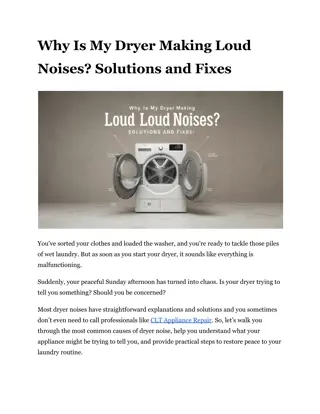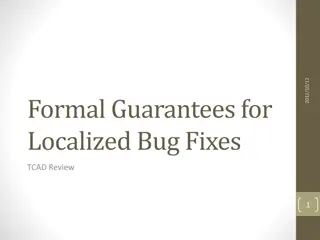Enhancements and Fixes in VNL Version 2.1 and 2.2
This readme document outlines the bug fixes and improvements implemented in VNL versions 2.1 and 2.2. In version 2.1, a bug affecting the annual averaging process was resolved, ensuring accurate calculation of annual average radiance. Additionally, radiance thresholds applied in previous versions for filtering out grid cells detected only once or twice have been removed. Version 2.2 introduces the use of data from multiple satellites and adjustments in median calculation criteria. Various changes in data processing and masking procedures were made across the different versions. These updates aim to enhance the accuracy and reliability of the VNL data composites.
Download Presentation

Please find below an Image/Link to download the presentation.
The content on the website is provided AS IS for your information and personal use only. It may not be sold, licensed, or shared on other websites without obtaining consent from the author.If you encounter any issues during the download, it is possible that the publisher has removed the file from their server.
You are allowed to download the files provided on this website for personal or commercial use, subject to the condition that they are used lawfully. All files are the property of their respective owners.
The content on the website is provided AS IS for your information and personal use only. It may not be sold, licensed, or shared on other websites without obtaining consent from the author.
E N D
Presentation Transcript
VNL v.2.1 Readme 1. There was a bug in the v2 annual averaging that has been resolved. The annual average radiance is calculated as a weighted average using the formula: (Sum of the monthly average radiances times the number of cloud-free coverages from that month)/the total number of cloud-free coverages in the year. In some cases, the monthly average radiances were being paired with a different month's cloud-free coverages. This has been corrected. 2. In VNL v2 radiance thresholds are applied to filter out (returned to the multiyear background) grid cells detected only one or two times from the full set of years. The average radiance threshold for grid cells detected once is 0.7 nanowatt and the threshold for gird cells detected twice is 0.5 nanowatts. This filtering has been removed in VNL v2.1.
VNL v.2.2 Readme 1. In VNL v 2.2 VIIRS data from multiple satellites have been used. It is a combination of 11 months data from SNPP, excluding 202208. Because of glitches in the SNPP satellite there are no data for the first 10 days of August, so SNPP 202208 was excluded. Instead, data from 3 months of NOAA- 20 202205, 202208 and 202209 were added to make the annual composite. 2. In VNL v2, and v2.1, the median calculation excludes months with less than 3 cloud-free coverages. The v2.2, however, includes any month with more than one cloud-free coverage. 3. In calculating the data range, for VNL v2, grid cells having zero cloud-free coverages and having median placeholder values of -1.5 were included. In v2.1, grid cells having zero cloud-free coverages, and marked with median values of zero were included. In v2.2, all grid cells lacking median values were excluded.
Monthly DNB Composites Average Radiance Cloud-free observations Total observations VNL V.2 Annual DNB Composites Skip months with less than 3 cloud-free observations Total observations Cloud-free observations Min, max, average, and median radiance grids 3x3 data range from median Multiyear DNB Composites Max of median radiances 3x3 Max median data range Percent cloud-free observations Multiyear DR Threshold Grid From % cloud-free versus DR scattergram for confirmed background areas. Annual DR Masked Medians Zero out radiances in grid cells where DR is below threshold. Aurora Filtering Raise DR threshold to 1.0 in north aurora zone. Zero out radiances in south aurora zone. Multiyear Masked Median Draw north and south auroral zone vector polygons Multiyear Masked Median Draw vector polygons on residual aurora features for masking. North Aurora Cleanup Apply residual aurora off mask to zero out aurora noise in masked medians. Multiyear Detection Tally Define mask for detection tallies of 1 and 2 across annual time series. Low Tally Cleanup Apply tally 1 and 2 off mask with masked median radiance threshold of 0.7 nW/cm2/sr for single detections and 0.5 for double detections. Annual Masked Radiances Apply lit grid cell mask to the annual average and median radiance grids.
Monthly DNB Composites Average Radiance Cloud-free observations Total observations VNL V.2.1 Annual DNB Composites Skip months with less than 3 cloud-free observations Total observations Cloud-free observations Min, max, average, and median radiance grids 3x3 data range from median Multiyear DNB Composites Max of median radiances 3x3 Max median data range Percent cloud-free observations Multiyear DR Threshold Grid From % cloud-free versus DR scattergram for confirmed background areas. Annual DR Masked Medians Zero out radiances in grid cells where DR is below threshold. Aurora Filtering Raise DR threshold to 1.0 in north aurora zone. Zero out radiances in south aurora zone. Multiyear Masked Median Draw north and south auroral zone vector polygons Multiyear Masked Median Draw vector polygons on residual aurora features for masking. North Aurora Cleanup Apply residual aurora off mask to zero out aurora noise in masked medians. Annual Masked Radiances Apply lit grid cell mask to the annual average and median radiance grids.
Monthly DNB Composites Average Radiance Cloud-free observations Total observations VNL V.2.2 Annual DNB Composites Mix of VIIRS data from multiple satellites Skip months with less than 1 cloud-free observations Total observations Cloud-free observations Min, max, average, and median radiance grids 3x3 data range from median Multiyear DNB Composites Max of median radiances 3x3 Max median data range Percent cloud-free observations Multiyear DR Threshold Grid From % cloud-free versus DR scattergram for confirmed background areas. Annual DR Masked Medians Zero out radiances in grid cells where DR is below threshold. Aurora Filtering Raise DR threshold to 1.0 in north aurora zone. Zero out radiances in south aurora zone. Multiyear Masked Median Draw north and south auroral zone vector polygons Multiyear Masked Median Draw vector polygons on residual aurora features for masking. North Aurora Cleanup Apply residual aurora off mask to zero out aurora noise in masked medians. Annual Masked Radiances Apply lit grid cell mask to the annual average and median radiance grids.























